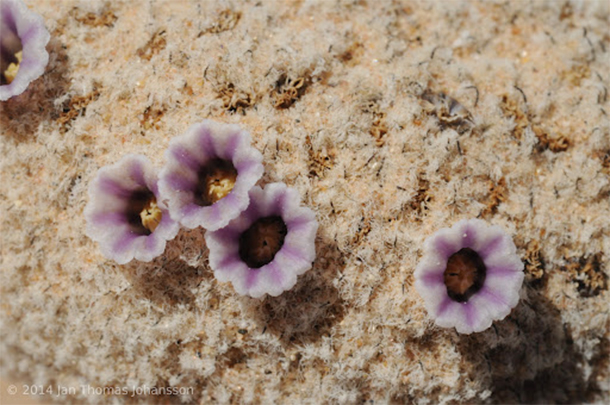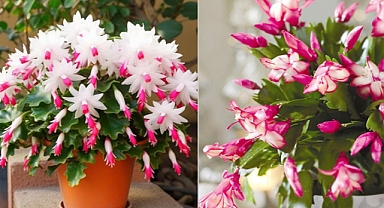A Rare and Unique Desert Flower
Pholisma sonorae, popularly called sand food, stands out as one of the most extraordinary wildflowers in North America. This unusual plant thrives in arid sand dunes, featuring a fleshy stem that can extend up to two meters beneath the surface. Above ground, the plant’s top emerges as a small, rounded or oval structure, resembling a mushroom if the shifting sands expose part of the buried stem. In early spring, this peculiar structure blossoms with tiny flowers that are pink to purple, accented by delicate white edges. One of the most striking features of Pholisma sonorae is its complete lack of chlorophyll. To survive, it latches onto the roots of desert shrubs, extracting essential nutrients. Surprisingly, this parasitic relationship does not seem to harm the host plants. In some cases, the sand food plant's weight can surpass that of its host, highlighting its impressive resource-acquisition ability.The plant’s survival is a marvel of adaptation. Seedlings of this parasitic species manage to locate host roots buried deep within the sand. A closely related species, Pholisma arenarium, achieves this through specialized "pilot roots" that burrow as deep as two feet underground. Once they detect a host shrub, these pilot roots deploy "haustorial roots" to connect with and penetrate the host roots, siphoning off carbohydrates and amino acids essential for growth. This process may be aided by shifting sands that carry seeds deeper into the ground, as well as by animals like harvester ants and rodents that inadvertently transport the seeds while burrowing near host shrubs.
One of the most striking features of Pholisma sonorae is its complete lack of chlorophyll. To survive, it latches onto the roots of desert shrubs, extracting essential nutrients. Surprisingly, this parasitic relationship does not seem to harm the host plants. In some cases, the sand food plant's weight can surpass that of its host, highlighting its impressive resource-acquisition ability.The plant’s survival is a marvel of adaptation. Seedlings of this parasitic species manage to locate host roots buried deep within the sand. A closely related species, Pholisma arenarium, achieves this through specialized "pilot roots" that burrow as deep as two feet underground. Once they detect a host shrub, these pilot roots deploy "haustorial roots" to connect with and penetrate the host roots, siphoning off carbohydrates and amino acids essential for growth. This process may be aided by shifting sands that carry seeds deeper into the ground, as well as by animals like harvester ants and rodents that inadvertently transport the seeds while burrowing near host shrubs. A Desert Treasure with Cultural Significance
A Desert Treasure with Cultural Significance
Pholisma sonorae is native to a limited range, found in the Algodones Dunes of southeastern California, parts of Arizona, and the sand dunes of El Gran Desierto in Sonora, Mexico. Historically, Indigenous tribes appreciated this plant as a food source, consuming its fleshy stem raw or roasted over an open flame.This rare flowering plant serves as a fascinating example of how life adapts and thrives under extreme desert conditions, balancing parasitism and coexistence in a delicate desert ecosystem.
Pholisma sonorae, popularly called sand food, stands out as one of the most extraordinary wildflowers in North America. This unusual plant thrives in arid sand dunes, featuring a fleshy stem that can extend up to two meters beneath the surface. Above ground, the plant’s top emerges as a small, rounded or oval structure, resembling a mushroom if the shifting sands expose part of the buried stem. In early spring, this peculiar structure blossoms with tiny flowers that are pink to purple, accented by delicate white edges.
 One of the most striking features of Pholisma sonorae is its complete lack of chlorophyll. To survive, it latches onto the roots of desert shrubs, extracting essential nutrients. Surprisingly, this parasitic relationship does not seem to harm the host plants. In some cases, the sand food plant's weight can surpass that of its host, highlighting its impressive resource-acquisition ability.The plant’s survival is a marvel of adaptation. Seedlings of this parasitic species manage to locate host roots buried deep within the sand. A closely related species, Pholisma arenarium, achieves this through specialized "pilot roots" that burrow as deep as two feet underground. Once they detect a host shrub, these pilot roots deploy "haustorial roots" to connect with and penetrate the host roots, siphoning off carbohydrates and amino acids essential for growth. This process may be aided by shifting sands that carry seeds deeper into the ground, as well as by animals like harvester ants and rodents that inadvertently transport the seeds while burrowing near host shrubs.
One of the most striking features of Pholisma sonorae is its complete lack of chlorophyll. To survive, it latches onto the roots of desert shrubs, extracting essential nutrients. Surprisingly, this parasitic relationship does not seem to harm the host plants. In some cases, the sand food plant's weight can surpass that of its host, highlighting its impressive resource-acquisition ability.The plant’s survival is a marvel of adaptation. Seedlings of this parasitic species manage to locate host roots buried deep within the sand. A closely related species, Pholisma arenarium, achieves this through specialized "pilot roots" that burrow as deep as two feet underground. Once they detect a host shrub, these pilot roots deploy "haustorial roots" to connect with and penetrate the host roots, siphoning off carbohydrates and amino acids essential for growth. This process may be aided by shifting sands that carry seeds deeper into the ground, as well as by animals like harvester ants and rodents that inadvertently transport the seeds while burrowing near host shrubs. A Desert Treasure with Cultural Significance
A Desert Treasure with Cultural SignificancePholisma sonorae is native to a limited range, found in the Algodones Dunes of southeastern California, parts of Arizona, and the sand dunes of El Gran Desierto in Sonora, Mexico. Historically, Indigenous tribes appreciated this plant as a food source, consuming its fleshy stem raw or roasted over an open flame.This rare flowering plant serves as a fascinating example of how life adapts and thrives under extreme desert conditions, balancing parasitism and coexistence in a delicate desert ecosystem.









